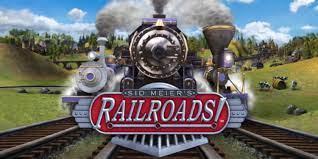Sid Meier’s Railroads came out in 2006 and was the fourth and final game in the Railroad Tycoon series. It set a high bar for games in the “Tycoon” genre. Sid Meier is probably best known for his empire-building simulation games in the Civilization series.
However, I think his best work is the Railroad Tycoon series, which has a bit of a cult following among people who grew up in the golden age of simulation games. Sid Meier’s Railroads is now on smartphones in a modern, touch-friendly version made possible by Feral Interactive. This is a good fit for the game’s fans, who are mostly older millennials.
Sid Meier’s Railroads was ahead of its time when it came out in the early 2000s. Players had to build a train company in different real-world and made-up settings.
I played the first version on PC when I was in college, and I’ve been looking forward to putting my more experienced mind to work on this game’s brilliant economics and gameplay. So, here’s my review of the mobile version of Sid Meier’s Railroads.
Sid Meier’s Railroads Review: Price and Supported Devices
Sid Meier’s Railroads is still playable on PC through Steam and GOG, but it is more important now that it has been ported to iOS and Android. The game costs Rs. 399 on Android and Rs. 499 on iOS. Most of the gameplay is the same on both Android and iOS, but I suggest playing this on a tablet or a phone with a big screen so you can see and read smaller details more easily.
Compatibility within the iOS and Android ecosystems depends a lot on your device, but most current iPhone models and Android smartphones from different makers will support the game.
Feral Interactive says that the game can’t be installed on some devices, but if you can install it, you’ll probably have a good time running it. On both systems, the file size is 1.7GB. I played Sid Meier’s Railroads on an iPad mini (5th Gen, 2019) (Review) that was running iPadOS 16.3.
Sid Meier’s Railroads Review: Controls
The original game was controlled with a mouse and keyboard. The new port for iOS and Android is made for touchscreen phones. It’s impressive how well some parts of this game work with touch controls, especially track layouts and building, where you can point and tweak the way you want the track to be laid with great accuracy.
Also, pinch-to-zoom makes it easier than ever to zoom in and out. This fixes some of the things I liked least about the first game.
Other parts of the touch controls can be a little tricky, especially when it comes to selecting a specific place on the screen, like a town’s supply and demand numbers or a track termination to keep building. Most of the time, this was solved by zooming in to make the touch zone bigger or get a better view, but this added extra steps that were often annoying.
All of this works if you’re playing the game on a computer with a screen that’s at least a few inches wide. If you’re on a smartphone, it might be hard to read the small numbers around the finances and available stocks of different packages in towns and cities. Most of the time, zooming in and out will make it easier, but most games already have a lot going on, so there’s no need to add more steps.
Sid Meier’s Railroads Review: Gameplay and Performance
Sid Meier’s Railroads is about starting and running a train company, but there’s a lot more to it than just laying down tracks and picking engines to run on them. The game is based on a complicated system that looks at the demand and supply of different raw materials, finished goods, passengers, and mail. The key to winning is to set up a network that gets products to where they are needed.
This means, of course, that you need to know how each map’s economy works and connect the farms and mines that supply raw materials like grain, coal, wood, and more to the companies in towns and cities that turn these raw materials into finished goods like furniture, steel, and processed food.’
You can make money just by moving the raw materials, but the real money is in making sure that the finished things also get to where they are needed.
You can make things more interesting by adding AI players who are fighting with you. This forces you to build tracks around existing ones and splits up the goods that can be moved.
I finally realized that it was better to make shorter routes that moved people and goods quickly between three or four places than longer ones. Still, you may have to run a long route to get things to the right place, especially if one of the scenario goals calls for it.
The maps in Sid Meier’s Railroads are an interesting mix of real-world and made-up details. Real-world maps show different parts of the US and Europe based on how the train industries grew in these places and how they helped their economies grow during the industrial revolution.
It also helps that you know some of the town and city names, which makes it easier to plan and find your way around.
In this way, the names of the cities on the imaginary maps can be a bit confusing. But because of where they are, they are often much more difficult. To save money on the high costs of building bridges and tunnels, you’ll build tracks around slopes or through passes. Some maps are made up of a bunch of islands, which means that building a track usually means building expensive bridges over water.
All of this is backed up by the rude and often taunting comments of AI players, who are always challenging you during bidding wars or if you try to set up a station in a town where they are already present.
There is also a simplified corporate aspect to all of this. You own stock in your own company, but all players can buy stock in rival companies with the goal of buying out the competition and then merging or selling the assets of the competitor. Selling stocks is a fast way to get money for growth and development, but it also comes with risks.
In Sid Meier’s Railroads, there are different levels of challenge. These levels set the costs and other economic factors that will affect how you play the game.
You can also make the routing method easier or harder, which will change how trains on the same stretch of track work together. There are no crashes, which is good, but trains can get stuck (sometimes for a long time) if too many lines use the same stretch of track and you don’t add double or triple parallel tracks.
Verdict
In the early 2000s, Sid Meier’s Railroads and the rest of the Railroad Tycoon games were ahead of their time. The new port by Feral Interactive also makes a training scenario that is pretty fun and, for a game that is almost 20 years old, feels surprisingly up-to-date. All of this can now be played on a smartphone or tablet, which is probably the most amazing thing about it.
Read More:
Google, Microsoft and 15 other technology companies headed by Indian-origin executives
How to Prevent iPhone Thieves from Locking You Out Of Your Own Device
Students in Trouble in Utah Canyon Are Saved by A Satellite Call for Help in A Crisis.












